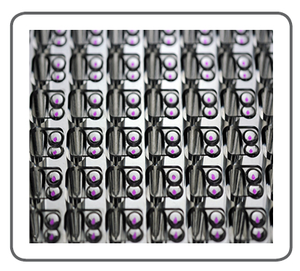In-Meso Crystallization Plate
protein wells coated with monoolein
| Catálogo Nº | Apresentação | Preço (R$) | Comprar |
|---|---|---|---|
| CPL-161-2 | 2 pcs. | Sob demanda | Adicionar ao Carrinho |
| CPL-161-10 | 10 pcs. | Sob demanda | Adicionar ao Carrinho |

Fig. 1: In-Meso Crystallization Plate, monoolein is visualized with a purple dye
Envio: shipped on blue ice
Condições de armazenamento: store at -20 °C
Validade: 12 months
Descrição:
LCP crystallization is the most popular method for membrane protein structure determination. Experiments are typically done in batch format. However, it is well known from the crystallization of soluble proteins that vapor diffusion can be a lot more powerful. The controlled in meso phase (CIMP) method combines the benefits of LCP and vapor diffusion to push membrane protein crystallization to new limits [1]. The patent-pending In-Meso Crystallization Plate provides an easy start with this revolutionary method.
The CIMP technology
In contrast to other LCP methods, CIMP can be setup using standard nanoliter dispensing equipment capable of dispensing 100 nl volumes. The protein wells are precoated with lipid (e.g. monoolein). Mixing of the protein suspension with the lipid is not required, as the protein passively diffuses into the lipid coating. In effect, In-Meso Crystallization Plates allow for the setup of a vapour diffusion experiment in a lipidic cubic phase environment.
Because of the diversity of proteins, the Experimental Protocol provided below can only give first guidelines. Optimization factors include, but are not limited to:
- Concentration of target protein: typically 2-5 mg/ml, concentrations up to 15 mg/ml have been successfully used
- Nature of lipid: Standard plates contain monoolein, other lipids or mixtures are available upon request
- Choice of precipitant solution: Avoid solutions containing alcohols, other organic solvents or PEG concentrations higher than 20%, as these may dissolve the LCP phase
Avoid pH > 8.0 as this destabilizes the monoolein - Dilution of precipitant solution: Dilutions from 1:1 to 1:10 or higher may be used, a good starting point is a 1:4 dilution
1. Equilibrate the In-Meso Crystallization Plate to room temperature by incubation for at least 10 min.
Note: Do not unpack the plate before reaction setup!
2. Prepare protein solutions concentrated 2 mg/ml to 5 mg/ml for first trials.
Tip: For optimization, test two different protein concentrations in the two parallel wells.
3. Prepare suitable dilutions of the precipitant solutions.
4. Unpack the In-Meso Crystallization Plate, and dispense 100 nL of the protein solution onto the dry lipid in each protein well using a nanoliter robot.
Note: The In-Meso Crystallization Plate is based on the Swissci MRC 2-well plate, so that similar teaching protocols can be used.
5. Seal with tape, and incubate at 18-22°C for 3 h.
Note: It is crucial to incubate at no less than 18°C in all steps.
6. Dispense 50 μL each of the 96 undiluted precipitant solutions into the reservoir wells of the In-Meso Crystallization Plate using a micropipettor or pipetting robot.
7. Dispense 100 nL each of the 96 diluted precipitant solutions from the spare deepwell block into the corresponding protein wells of the In-Meso Crystallization Plate using a nanoliter robot.
8. Seal with tape, and incubate at 18-22°C.
9. Monitor the plates on a regular basis using a microscope. During the first two weeks, a daily inspection is recommended.
Precipitant Solution
Dilution of the precipitant solution is a crucial parameter in the CIMP setup. As for any vapour diffusion experiment, precipitant dilutions have the advantage that almost never protein precipitants are obtained, and the exposure to salt is reduced. The major advantage however in connection with the CIMP technology is that one can influence the concentration of the protein at the end of the experiment, i.e. when the equilibrium is reached. The higher the salt concentration gradient between the reservoir and the protein well, the stronger the osmotic force within the vapour diffusion compartment. Strong osmotic forces lead to high concentration factors, and low water content within the protein well. The water content of the in meso phase, in turn, yields different phases within the phase diagram of the monoolein:water mixture. This way, one can reach different in meso phases by adjusting the water content of the protein well.
Referências selecionadas:
[1] Kubicek et al. (2012) Controlled In Meso Phase Crystallization - A Method for the Structural Investigation of Membrane Proteins. PLoS ONE 7:e35458.
